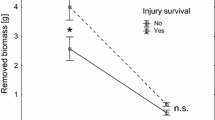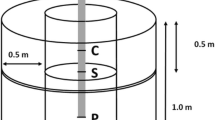Abstract
To understand the spatial structure of monospecific Tugai forests (Xinjiang Province, China) growing as gallery woods nourished by ground water, root suckering in Populus euphratica was studied by a combination of morphological and molecular analyses. Seedlings grow a deep tap root and keep this as adult trees, whereas root suckers never develop a tap root but utilize the horizontally stretching root of their parent trees. The resulting reverse “T” root architecture distinguishes reliably even adult root suckers from generatively grown trees. Due to assimilate input from the root sucker, the distal root (pointing away from the parent tree) becomes thicker soon than its proximal root, which allows determination of the direction of vegetative growth. One stand including 279 young trees germinated from seeds and 267 root suckers was mapped completely, and selected suckers were assigned to parent trees by genotyping with microsatellite DNA. Root suckers develop up to 40 m away from parent trees on horizontal “spacer” roots, usually originating not deeper than 20 cm below surface. Trees begin with root suckering between 10 and 15 years, shortly before reaching flowering age. Cutting experiments indicated reduced survival of young root suckers disconnected from the parent tree. Without a tap root and with a rooting point close to the surface, declining ground water levels should lower the fitness of root suckers even more than that of generatively grown trees.





Similar content being viewed by others
References
Banno H, Ikeda Y, Niu OW, Chua NH (2001) Over expression of Arabidopsis ESR1 induces initiation of shoot regeneration. Plant Cell 13:2609–2618
Barnes BV (1966) The clonal growth habit of American aspens. Ecology 47:439–447. doi:10.2307/1932983
Bärring U (1988) On the reproduction of aspen (Populus tremula L.) with emphasis on its suckering ability. Scand J For Res 3:229–240. doi:10.1080/02827588809382511
Blake TJ, Atkinson SM (1986) The physiological role of abscisic acid in the rooting of poplar and aspen stump sprouts. Physiol Plant 67:638–643. doi:10.1111/j.1399-3054.1986.tb05070.x
Bosela MJ, Ewers FW (1997) The mode of origin of root buds and root sprouts in the clonal tree Sassafras albidum (Lauraceae). Am J Bot 84:1466–1481. doi:10.2307/2446609
Bruelheide H, Manegold M, Jandt U (2004) The genetic structure of Populus euphratica and Alhagi sparsifolia stands in the Taklimakan desert. In: Runge M, Zhang X (eds) Ecophysiology and habitat requirements of perennial plant species in the Taklimakan desert. Shaker Verlag, Aachen, pp 153–160
Buell MF, Buell HF (1959) Aspen invasion of prairie. Bull Torrey Bot Club 86:264–265. doi:10.2307/2482844
Busgen M, Munch E (1929) The structure and life of forest trees, 3rd edn. Wiley, New York
Callaghan TV, Carlson BA, Jónsdóttir IS, Svenson BM, Jonasson S (1992) Clonal plants and environmental change. Oikos 63:341–347. doi:10.2307/3544959
Cook RE (1985) Growth and development in clonal plants. In: Jackson JBC, Buss LW, Cook RE (eds) Population biology and evolution of clonal organisms. Yale University Press, pp 259–292
DeByle NV (1964) Detection of functional intraclonal aspen root connections by tracers and excavation. For Sci 10:386–396
Del Tredici P (2001) Sprouting in temperate trees: a morphological and ecological review. Bot Rev 67:121–140. doi:10.1007/BF02858075
Erikson O, Jerling L (1990) Hierarchical selection and risk spreading in clonal plants. In: van Groenendael J, de Kroon H (eds) Clonal growth in plants: regulation and function. SPB Academic Publishing, Hague, pp 79–94
Eusemann P, Fehrenz S, Schnittler M (2009) Development of two microsatellite multiplex PCR systems for high throughput genotyping in Populus euphratica. J For Res (accepted)
Farmer RE (1962) Aspen root sucker formation and apical dominance. For Sci 8:403–410
Gavin DG, Peart DR (1999) Vegetative life history of a dominant rain forest canopy tree. Biotropica 31:288–294. doi:10.1111/j.1744-7429.1999.tb00140.x
Good R (1964) The geography of the flowering Plants. Wiley, New York
Gries D, Zeng F, Foetzki A, Arndt SK, Bruelheide H, Thomas FM, Zhang X, Runge M (2003) Growth and water relations of Tamarix ramosissima and Populus euphratica on Taklamakan desert dunes in relation to depth to a permanent water table. Plant Cell Environ 26:725–736. doi:10.1046/j.1365-3040.2003.01009.x
Gries D, Foetzki A, Arndt SK, Bruelheide H, Thomas FM, Zhang Z, Runge M (2005) Production of perennial vegetation in an oasis-desert transition zone in NW China—allometric estimation, and assessment of flooding and use effects. Plant Ecol 181:23–43. doi:10.1007/s11258-004-7808-2
Harper JL (1977) Population biology of plants. Academic Press, New York
Holm T (1925) On the development of buds upon roots and leaves. Ann Bot (Lond) 39:867–881
Jenik J (1994) Clonal growth in woody plants: a review. Folia Geobot Phytotaxon 29:291–306. doi:10.1007/BF02803802
Kemperman JA (1978) Sucker-root relationships in aspen. For Res Notes 12:1–4
Kemperman JA, Barnes BV (1976) Clone size in American aspens. Can J Bot 54:2603–2607. doi:10.1139/b76-280
Klekowski EJ Jr (1997) Somatic mutation theory of clonality. In: de Kroon H, van Groenendael J (eds) The ecology and evolution of clonal plants. Backhuys Publishers, Leiden, pp 227–241
Klimešová J, Klimeš L (2003) Resprouting of herbs in disturbed habitats: is it adequately described by Bellingham-Sparrow’s model? Oikos 103:225–229. doi:10.1034/j.1600-0706.2003.12725.x
Kormanic PP, Brown CL (1967) Root buds and the development of root suckers in sweetgum. For Sci 13:338–345
Landa K, Benner B, Watson M, Gartner J (1992) Physiological integration for carbon in mayapple (Podophyllum peltatum), a clonal perennial herb. Oikos 63:348–356. doi:10.2307/3544960
Levine CM, Stromberg JC (2001) Effects of flooding on native and exotic plant seedlings: implications for restoring south-western riparian forests by manipulating water and sediment flows. J Arid Environ 49:111–131. doi:10.1006/jare.2001.0837
Lian C, Oishi R, Miyashita N, Hogetsu T (2004) High somatic instability of a microsatellite locus in a clonal tree, Robinia pseudoacacia. Theor Appl Genet 108:836–841. doi:10.1007/s00122-003-1500-0
Liu M (1997) Atlas of China’s nature and geography. Zhongguo Tuce Chubanshe, Beijing (in Chinese)
Marshall C (1990) Source-sink relations of interconnected ramets. In: van Groenendael J, de Kroon H (eds) Clonal growth in plants: regulation and function. SPB Academic Publishing, Hague, pp 23–41
Pan JJ, Price JS (2001) Fitness and evolution in clonal plants: the impact of clonal growth. Evol Ecol 15:583–600. doi:10.1023/A:1016065705539
Peterson RL (1975) The initiation and development of root buds. In: Torrey JG, Clarkson DT (eds) Development and function of roots. Academic Press, New York, pp 125–162
Peterson RL, Jones RH (1997) Clonality in woody plants: a review and comparison with clonal herbs. In: de Kroon H, van Groenendael J (eds) The ecology and evolution of clonal plants. Backhuys Publishers, Leiden, pp 263–289
Pitelka LF, Ashmun JW (1985) Physiology and integration of ramets in clonal plants. In: Jackson JBC, Buss LW, Cook RE (eds) Population biology and evolution of clonal organisms. Yale University Press, pp 399–435
Price EAC, Marshall C, Hutchings MJ (1992) Studies of growth in the clonal herb Glechoma hederacea. I Patterns of physiological integration. J Ecol 80:25–38. doi:10.2307/2261060
Quereshi RA, Spanner DC (1971) Unidirectional movement of tracers along the stolon of Saxifraga sarmentosa. Planta 101:133–146. doi:10.1007/BF00387624
Raju MVS, Coupland RT, Steeves TA (1966) On the occurrence of root buds on perennial plants in Saskatchewan. Can J Bot 44:330–337. doi:10.1139/b66-004
Rodrigues RR, Torres RB, Metthes LRF, Pentha AS (2004) Tree species sprouting from root buds in a semideciduous forest affected by fires. Braz Arch Biol Technol 47:127–133. doi:10.1590/S1516-89132004000100017
Sharma A, Dwivedi BN, Singh B, Kumar K (1999) Introduction of Populus euphratica in Indian semi-arid trans Gangetic plains. Ann For 7:1–8
Song Y, Fan Z, Lei Z, Zhang F (2000) Research on water resources and ecology of Tarim River, China. Xinjiang Peoples Press, Urumqi (in Chinese)
Thevs N (2007) Ecology, spatial structure, distribution and utilization of the Tugai vegetation at the middle reaches of the Tarim River, Xinjiang, China. Cuvellier, Göttingen
Thevs N, Zerbe S, Peper J, Succow M (2008a) Vegetation and vegetation dynamics in the Tarim River floodplain of continental-arid Xinjiang, NW China. Phytocoenologia 38:65–84. doi:10.1127/0340-269X/2008/0038-0065
Thevs N, Zerbe S, Schnittler M, Nurbay A, Succow M (2008b) Structure, reproduction and flood-induced dynamics of riparian Tugai forests at the Tarim River in Xinjiang, NW China. Forestry 81:45–57. doi:10.1093/forestry/cpm043
Tuskan GA, Gunter LE, Yang ZK, Yin TM, Sewell MM, DiFazio SP (2004) Characterization of microsatellites revealed by genomic sequencing of Populus trichocarpa. Can J Res 34:85–93. doi:10.1139/x03-283
Wang S, Chen B, Li H (1996) Euphrates poplar forest. China Environmental Science Press, Beijing
Watson MA, Casper BB (1984) Morphogenetic constraints on patterns of carbon distribution in plants. Annu Rev Ecol Syst 15:233–258. doi:10.1146/annurev.es.15.110184.001313
Weisgerber H (1994) Populus euphratica. In: Schütt P (ed) Enzyclopedie der Holzgewächse. Ecomed, Landsberg/Lech
Westermann J, Zerbe S, Eckstein D (2008) Age structure and growth of degraded Populus euphratica floodplain forests in north-west China and perspectives for their ecology. J Integr Plant Biol 50:536–546. doi:10.1111/j.1744-7909.2007.00626.x
Wittrock VB (1884) Om rotskott hos örtartade växter, med särskild hänsyn till deras olika biologiska betydelse. Bot Not 1884:21–37
Zahner R, DeByle NV (1965) Effect of pruning the parent root on growth of aspen suckers. Ecology 46:373–375. doi:10.2307/1936349
Zimmermann MH, Brown CL (1971) Trees: structure and function. Springer Verlag, Berlin
Acknowledgments
We wish to thank our Chinese partners from the Department of Environmental resources, Xinjiang University, for help with translation, logistics and their general assistance during the field studies. In particular, the students B. Abula, Sh. Lin, K. Qiongying, W. Yongbin, W. Shan and A. Rozi. N. Abdusalih provided room for laboratory work and helped with critical remarks in the interpretation of root architectures. A special thank is due to Ghalip, our driver during the field work in the Tarim Basin. On the German side (Greifswald University) we are indebted to S. Abel, F. Gahlert, N. Jeschke, and also F. W. Spiegel (University of Arkansas) for help in field work and with tree ring determination. Furthermore we wish to thank V. Liebscher (Department of Biomathematics) for advice with data evaluation; and A. Klahr and S. Fehrenz for advice regarding the laboratory work. Financial support came from grants of the Deutsche Forschungsgemeinschaft (DFG, SCHN 1080/1-1), the VW-Foundation (I/78 636) and the DAAD partnership programe (PPP, D/05/06946).
Author information
Authors and Affiliations
Corresponding author
Additional information
Communicated by M. Zwieniecki.
Rights and permissions
About this article
Cite this article
Wiehle, M., Eusemann, P., Thevs, N. et al. Root suckering patterns in Populus euphratica (Euphrates poplar, Salicaceae). Trees 23, 991–1001 (2009). https://doi.org/10.1007/s00468-009-0341-0
Received:
Revised:
Accepted:
Published:
Issue Date:
DOI: https://doi.org/10.1007/s00468-009-0341-0




